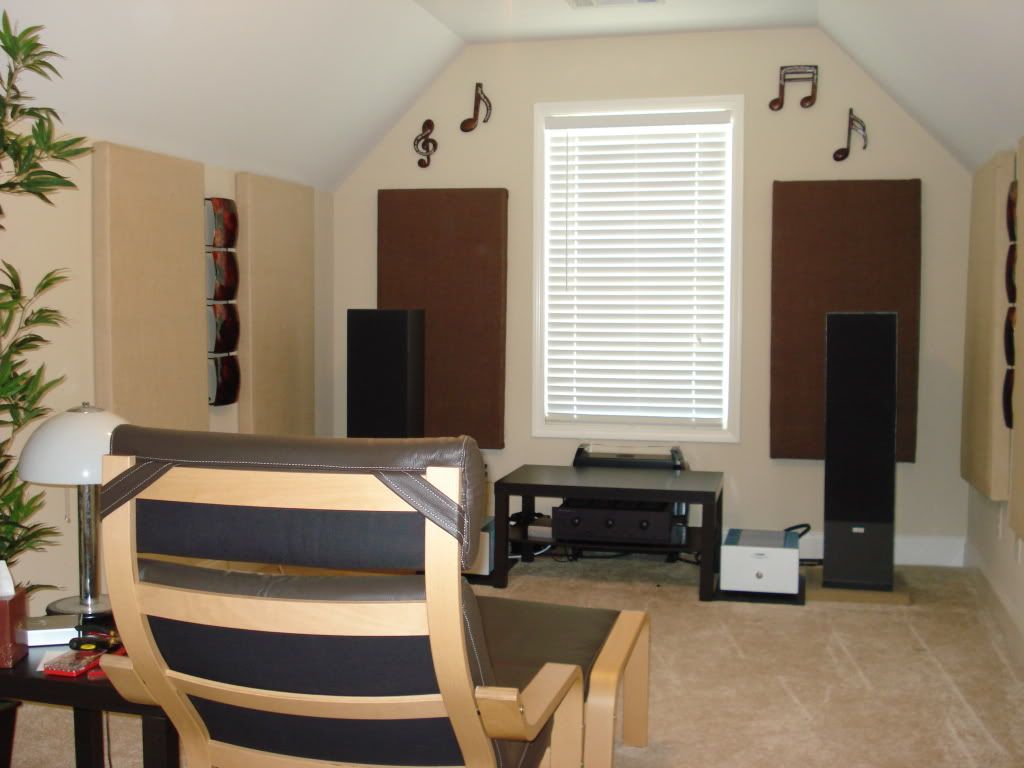 |
Audio Asylum Thread Printer Get a view of an entire thread on one page |
For Sale Ads |
 |
Audio Asylum Thread Printer Get a view of an entire thread on one page |
For Sale Ads |
71.227.222.185
I've experienced Gräf & Lantz wool felt and it's truly an excellent thing. I would expect that huge WAF/audiophile satisfaction could be met if custom designs were configured for listening room applications...
Follow Ups:
Owens Corning 703 sound insulation - 6 panels in each case - online about $60
1 1/2" Dry Wall Screws - Home Depot $3-4 per box
20 yards of Burlap Fabric - Joann Fabric $2.99/yd
20 - 1"x3"x8' lumber $0.94 each Home Depot
Staple Gun with 1/2" staples
Total Cost around $100 for 6 panels


Music Is The Bridge Between Heaven & Earth - 音楽は天国と地球のかけ橋
I noticed that you have the same IKEA chair that I have (also leather). I stopped using it for listening because the top piece (which can be removed) is very reflective and changes the sound if removed.
Try it.
You could always put a towel over the top piece to absorb reflections...:-)

Music Is The Bridge Between Heaven & Earth - 音楽は天国と地球のかけ橋
I use wool felt lining the inside surfaces of the EMIM midranges in my Infinity speakers to absorb cavity resonances. I saw a measureable smoothing of the midrange response using TrueRTA at 1/24th octave resolution, when the felt was in place.There are many different grades/densities of wool felt. I used 1/8" thick F10 grade wool felt in my work.
Wool felt has strong aborbance in the midrange region (attached graph of 1" thick wool felt aborption based on data from V.S.Mankovsky, "Acoustics of Studios and Auditoria").

Edits: 04/21/10
If you're treating walls rather than corners where bass traps are best placed, the usual reason for treatment is to reduce/control reflections. Unless the wall surface is giving you an unusually strong reflection at around 1 kHz for some reason, the wool felt that provided that data would not be a good choice. It would change the tonal balance of the reflected sound significantly from that of the direct sound and produce a tonal shift which I think would be quite noticeable.
What you want for wall treatment is quite even absorption behaviour over as wide a frequency range as possible, not good absorption over a quite narrow range which is what that felt is providing.
David Aiken
Agreed about the room uses, but it's just great for absorbing stray midrange energy inside a speaker!
An experienced audiophile friend uses the voice test on candidate wall treatment materials. This is done by speaking while walking up to a sample of the material, and listening for timbre changes in the reflected voice sound.
We were in a store one day when he showed me this technique. We got some very strange looks from other shoppers!
A medium wool felt gave the most natural sonic reflection.
-snip-
Gräf & Lantz,
I would suggest that you observe this worldwide internet audiophile forum post about a possible future product line/design option:
http://www.audioasylum.com/audio/tweaks/messages/16/169588.html
Many audiophiles worldwide have keen aesthetic interests (as well as their possible partners to please) concerning acoustic dampening of both home theater and 2-channel high-end audiophile listening environments.
see link:
http://en.wikipedia.org/wiki/Audiophile
Feel free to reply with questions.
Sincerely,
---
-snip-
Al, if Gräf & Lantz postures a positive reply, perhaps David Aiken and yourself (and others) might wish to colaborate in discourse with them about such an engineering-meets-art/design topic... Seems like a fun idea to me. RSVP
Regards,
Duster
:)
Hello: Somewhat off topic.... I've never considered felt , but it sounds promising. To help reduce inter cabinet resonance, I have considered (but not yet used), a thin cork or balsa wood
layer on the inside of my speaker cabinets - the kind that can be found in hobby & craft stores. Does anyone have any experience w. this? Thanks,Vasil
I've used balsa wood in platforms to reduce vibration, making a constrained layer construction by using 3 or 5 layers with the grain of each layer at right angles to that of adjacent layers as in plywood. I think balsa works quite well in that sort of use, you can construct a quite light but reasonably rigid platform quite easily. You should paint it with model aircraft dope to make the surface a little more resistant to scuffing.
David Aiken
Post a Followup:
| FAQ |
Post a Message! |
Forgot Password? |
|
||||||||||||||
|
||||||||||||||
This post is made possible by the generous support of people like you and our sponsors: